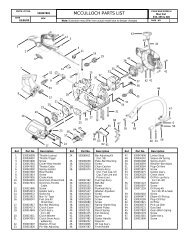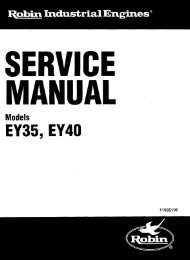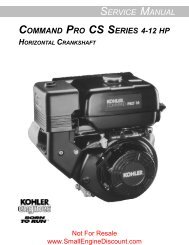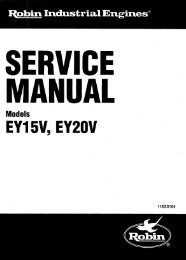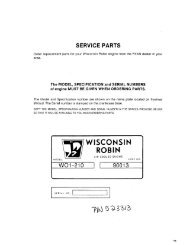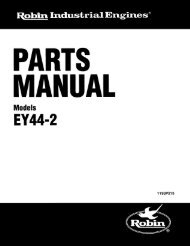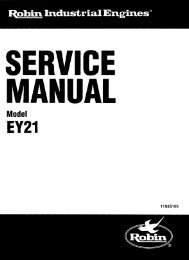4-CYCLE OVERHEAD VALVE ENGINES - Small Engine Discount
4-CYCLE OVERHEAD VALVE ENGINES - Small Engine Discount
4-CYCLE OVERHEAD VALVE ENGINES - Small Engine Discount
Create successful ePaper yourself
Turn your PDF publications into a flip-book with our unique Google optimized e-Paper software.
TESTING<br />
ENGINE KNOCKS<br />
1. Check the blade hub, blade adapter, or crankshaft coupler for loose fit, loose bolts, or crankshaft key<br />
damage. Remove, inspect, replace if necessary. Reinstall and re-torque the bolts to the proper torque.<br />
2. Check the flywheel key and the flywheel and crankshaft keyway for wear or partial shearing. Replace<br />
if any damage is evident. Tighten the flywheel nut to the proper torque.<br />
3. Check for the correct ignition module air gap.<br />
4. Remove the cylinder head and check for excessive carbon in the combustion chamber. Also check that<br />
the head gasket fit is correct, and the spark plug for proper reach and heat range (correct spark plug for<br />
the engine).<br />
5. Check for the proper valve lash using a feeler gauge.<br />
6. Check the internal components (piston, cylinder, connecting rod, crankshaft journal) for excessive<br />
clearance. See Chapter 10 under "Specifications".<br />
ENGINE OVERHEATS<br />
1. Make sure the engine is not being overloaded. Remove excess load (sharpen blades, limit operation<br />
speed, process less material).<br />
2. Check the oil level and viscosity. Add or replace as necessary.<br />
3. Check for clogged cooling fins or obstructions to the air flow. Remove the blower housing, clean and<br />
reinstall.<br />
4. Check the carburetor for correct adjustment or remove and clean the carburetor using tag wire and<br />
compressed air. See Chapter 3 under "Service."<br />
5. Check the engine R.P.M. setting using a vibratach or other tachometer and compare it to the R.P.M.<br />
settings found on microfiche card #30 according to the engine model and specification number. Adjust<br />
as necessary.<br />
6. Check the ignition timing. See Chapter 8 "Ignition - Service."<br />
7. Remove the cylinder head to check for excessive carbon buildup or a leaking head gasket. Clean or<br />
replace as necessary.<br />
SURGES or RUNS UNEVENLY<br />
1. Check the fuel cap to make sure it is venting. Loosen the cap and retry engine operation.<br />
2. Replace or clean the air filter.<br />
3. Check the carburetor adjustment or clean the carburetor. See Chapter 3 under "Service."<br />
4. Check the engine R.P.M. setting using a vibratach or other tachometer and compare it to the R.P.M.<br />
settings found on microfiche card # 30 according to the engine model and specification number. Adjust<br />
as necessary.<br />
5. Visually check all linkages. Check the governor shaft, throttle shaft, or pivot points for binding.<br />
6. Check the ignition module operation using a gap type tester installed between the high tension lead<br />
and spark plug. Check for intermittent spark.<br />
ENGINE MISFIRES<br />
1. Check the spark plug for the proper application or a fouled condition. Replace if questionable.<br />
2. Reset the carburetor following the adjustment procedure or clean the carburetor. See Chapter 3 under<br />
"Service."<br />
3. Check the ignition timing. See Chapter 8 under "Service."<br />
4. Check for carbon buildup in the combustion chamber.<br />
5. Check valve lash. Inspect the valves and valve seats for leakage. Check for scoring or discoloration on<br />
the valve stem in the valve guide area. Recut the valves and seats if questionable. See "Valve Service"<br />
in this chapter.<br />
Not For Resale<br />
www.<strong>Small</strong><strong>Engine</strong><strong>Discount</strong>.com<br />
63





